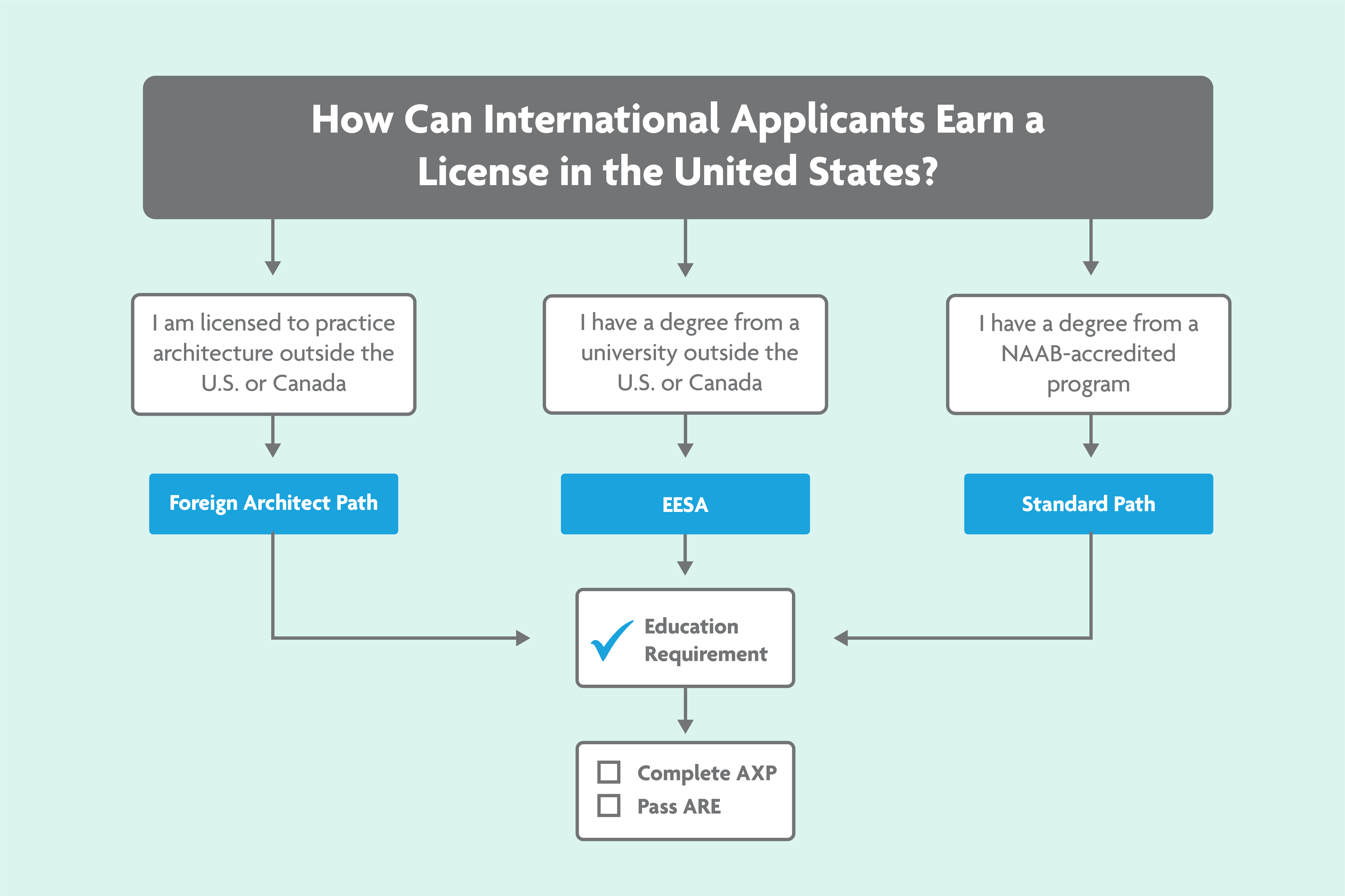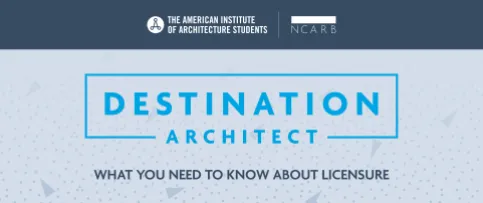If you are licensed as an architect outside of the United States or Canada or studied architecture abroad, you may have heard about the Foreign Architect Path or Education Evaluation Services for Architects (EESA). But what exactly are the two programs, and which one is right for you?
Here, we demystify the key components of both paths, so you can find the one that fits your needs and earn an architecture license!
How Does Licensing and Credentialing Work in the United States?
To practice architecture in the United States, you must have a license from the U.S. jurisdiction where you want to practice—there is no national license in the United States. The jurisdictions include the 50 states, the District of Columbia, Guam, the Northern Mariana Islands, Puerto Rico, and the U.S. Virgin Islands. Though the licensure process differs between jurisdictions, the basics of earning a license are similar.
Both the Foreign Architect Path and the EESA are means of fulfilling the education component of the standard path to licensure in the United States. For either path, you must still complete the Architectural Experience Program (AXP®) and the Architect Registration Examination (ARE®).
Which Path is Right for Me?
 The Foreign Architect Path is only for individuals who hold a license to practice architecture in a country other than the United States or Canada. The EESA is for individuals who hold a degree from a university outside the United State or Canada, but are not licensed to practice architecture. Both programs are alternative ways to satisfy the education requirement for licensure in a U.S. jurisdiction if you do not have a degree from a NAAB-accredited program. If you have a degree from a NAAB-accredited program and a foreign license or degree, completing the “standard path” to licensure that any U.S. candidate would follow is—in most cases—the simplest choice. Learn more about the standard path.
The Foreign Architect Path is only for individuals who hold a license to practice architecture in a country other than the United States or Canada. The EESA is for individuals who hold a degree from a university outside the United State or Canada, but are not licensed to practice architecture. Both programs are alternative ways to satisfy the education requirement for licensure in a U.S. jurisdiction if you do not have a degree from a NAAB-accredited program. If you have a degree from a NAAB-accredited program and a foreign license or degree, completing the “standard path” to licensure that any U.S. candidate would follow is—in most cases—the simplest choice. Learn more about the standard path.
What is the Foreign Architect Path?
Through the Foreign Architect Path, those licensed as an architect outside the U.S. or Canada can pursue an NCARB Certificate by verifying their license and completing the Architectural Experience Program® (AXP®) and the Architect Registration Examination® (ARE®)—both required for licensure in the United States. The NCARB Certificate is a nationally recognized credential that signals you’ve met the standards for licensure in the United States. Receiving NCARB certification would then allow you to apply for reciprocal licensure in U.S. jurisdictions that accept the Foreign Architect Path.
Note: If you’re not licensed in another country, you cannot pursue the Foreign Architect Path.
What is the Education Evaluation Services for Architects (EESA)?
Many people ask about EESA. Through the EESA review, conducted by the National Architectural Accrediting Board (NAAB), foreign-educated applicants can have their education compared to the NCARB Education Standard, which will determine areas of the NCARB Education Standard that have been met, and areas (if any) that are deficient. If your education doesn’t meet the NCARB Education Standard, any deficiencies must be addressed through additional coursework. Note that EESA is the only education evaluation service accepted by NCARB.

Learn More About the NCARB Certificate
The NCARB Certificate is a nationally recognized credential that can help you get licensed in the U.S. Our Certificate Guidelines explain the process.
Once your education has been determined to meet the NCARB Education Standard, you can earn your initial license in the United States by completing the AXP and ARE and applying to the jurisdiction where you want to practice. It is important to remember, however, that not all U.S. jurisdictions accept EESA evaluations of foreign degrees. You can find out which jurisdictions do accept this option in our Licensing Requirements Tool.
Note: Architects educated in the United States who don’t hold a degree from a NAAB-accredited program may also pursue an EESA in order to meet the standards for reciprocal licensure or NCARB certification.
How Do I Apply for Either Path?
Before you start the application process for either path, you should first contact NCARB’s Customer Relations team to confirm the path you're eligible for. If you haven’t already begun your NCARB Record, you'll need to create and pay for an NCARB Record—a verified account of your education, experience, and examination history that is necessary to prove you meet the requirements for licensure and/or NCARB certification.
To apply for the Foreign Architect Path, you must first meet the requirements outlined on ncarb.org. Once you meet the requirements, you must go to your NCARB Record, ensure your foreign registration and education are listed in your Record, and indicate your interest in the Foreign Architect Path by checking the box prompt that comes up.
Likewise, to apply for an education evaluation, you must log in to your NCARB Record and request an invitation to apply for EESA. Once you have received an EESA invitation, you must pay the EESA fee through your NCARB Record and send all required documents, including an academic transcript(s) and descriptions of all courses taken from each post-secondary institution, to NAAB.
What Are the Fees for Each Path?
The Foreign Architect Path has a maximum fee of $1,280, depending on the cost of your initial NCARB Record application—this is the same as the cost of a standard Certificate application. The Certificate application fee does not include the cost of completing the ARE, which costs $235 per division. To learn more about the Foreign Architect Path, see NCARB’s Certification Guidelines.
Fees for EESA services are set by the NAAB. At the time of publication, these can range from $1,250 to $2,500, depending on the program you graduated from. To learn more about EESA and the fees associated with the program, review NAAB’s information on EESA Fees Structure.
Important References:
- Licensing Requirement Tool: Look up requirements for the jurisdiction where you would like to practice
- Foreign Applicants: Access all related resources on NCARB.org
- NCARB Certification Guidelines: Find requirements for the Foreign Architect Path
- NCARB Education Guidelines: Read education requirements and options, including EESA
- Foreign Architect Documentation Checklist: Review step-by-step instructions for the Foreign Architect Path



